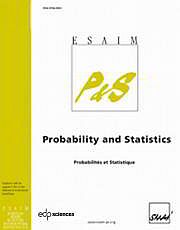Article contents
Asymptotics of counts of small components in random structuresand models of coagulation-fragmentation
Published online by Cambridge University Press: 03 June 2013
Abstract
We establish necessary and sufficient conditions for the convergence (in the sense offinite dimensional distributions) of multiplicative measures on the set of partitions. Themultiplicative measures depict distributions of component spectra of random structures andalso the equilibria of classic models of statistical mechanics and stochastic processes ofcoagulation-fragmentation. We show that the convergence of multiplicative measures isequivalent to the asymptotic independence of counts of components of fixed sizes in randomstructures. We then apply Schur’s tauberian lemma and some results from additive numbertheory and enumerative combinatorics in order to derive plausible sufficient conditions ofconvergence. Our results demonstrate that the common belief, that counts of components offixed sizes in random structures become independent as the number of particles goes toinfinity, is not true in general.
Keywords
Information
- Type
- Research Article
- Information
- Copyright
- © EDP Sciences, SMAI, 2013
References
- 1
- Cited by

